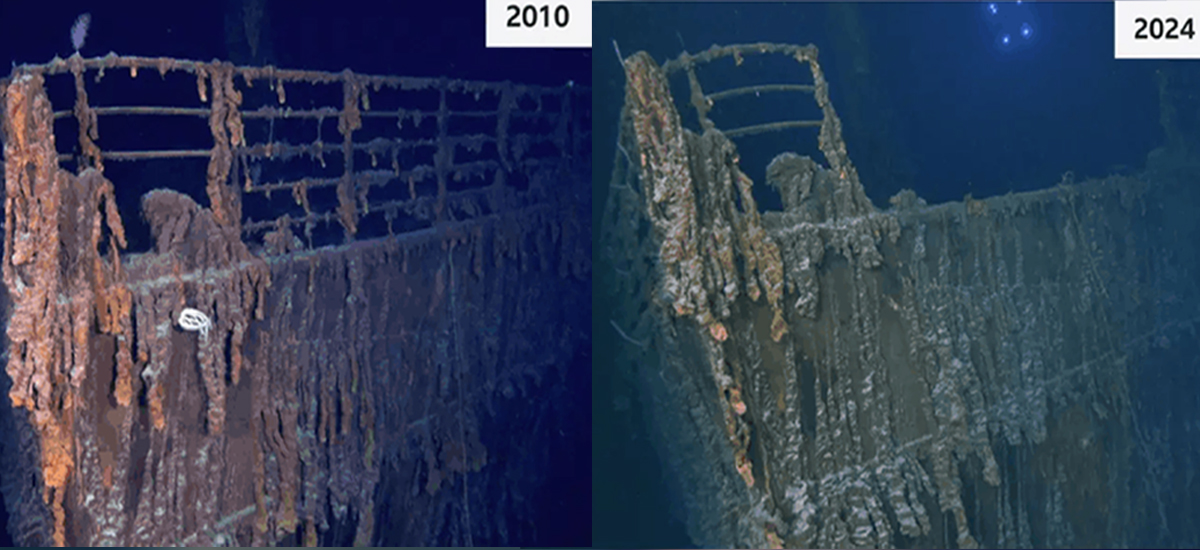
The wreck of the Titanic is showing clear signs of decay on the sea floor at its resting place miles below the surface. What will its final fate be?
The RMS Titanic has spent more than 112 years in the crushing, total darkness of the deep ocean. When it sank on a cold, moonless night in April 1912, the 883ft (269m) long vessel broke apart, sending a rain of debris cascading down nearly 12,500ft (3.8km) to the silty ocean floor. The ship took more than 1,500 passengers and crew with it to their deaths.
Apart from the occasional visit from deep-sea submersibles and salvage missions bringing small artefacts to the surface, the wreckage has remained undisturbed as it has undergone the slow, steady process of decay.
Images from a recent expedition to the Titanic's wreck nearly 400 miles (640km) south-east of the Newfoundland coast have revealed the effects of this deterioration. Images of the Titanic's Bow, with its distinctive railings, looming out of the darkness have become iconic since the discovery of the wreck in 1985. But in 2022, scans of the wreck showed the railing was starting to buckle and in the most recent visit to the wreck in 2024, a significant section has fallen now away.
It is a very visual indication of how the extreme environment in the ocean depths is breaking apart what remains of the world's most famous ship. The pressure of the ocean above it, water currents on the sea floor and iron-eating bacteria are causing the structure to collapse. And as it does so, the vessel is having a surprising impact on the ocean habitat around it.
Under pressure
As it sank, the Titanic split into two main sections – the bow and the stern, which came to rest nearly 2,000 ft(600m) apart from the sea floor. The stern section sunk directly to the bottom, while the bow sank more gradually.
Stretching more than 1.3 miles(2km) from behind the stern to beyond the bow is a scattering of belongings, fittings, fixtures, coal and ship parts that fell away as the Titanic sank. Most of the debris is found clustered around the stern section, which is a twisted tangle of steel, while the bow has remained largely intact. This is because when the vessel hit the iceberg, the impact tore apart a riveted section of the hull, allowingan estimated 43,000 tonnes of water to flood into the bow. When the stern section broke away, it still had compartments filled with air. As it spun towards the sea floor, the rapidly increasing water pressure caused the structure around these air pockets to implode, scattering metal, statues, champagne bottles and passengers' possessions as it did so.
On the sea bed, the Titanic endures water pressure of around 40MPa, which are 390 times greater than those on the surface. But as there are no air pockets left in the vessel, further catastrophic implosions are unlikely.
Instead, the weight of the vast ship itself is now playing a part in its demise. As the 52,000 tonnes of steel settle into the ocean floor, it is creating twisting force across the steel hull that is pulling the ship apart. Large cracks and fissures have been seen appearing in the steel plates of the hull by successive submersible missions, and the decking areas have been collapsing inwards.
"The iconic silhouette of the wreck will gradually change year by year – and not in its favour," says Gerhard Seiffert, a deep-water marine archaeologist who in 2022 led an expedition to capture high-resolution scans of Titanic wreckage with the deep sea mapping company Magellan. "The drop of the railing segment, which was still in place in 2022 when I was on the wreck with Magellan, or the collapse of the ceiling in the captain's bathroom years before may serve as examples," he says.
Corrosion, Seiffert says, is gradually weakening the structure of the ship as steel plates, beams and other load-bearing elements become thinner.
Devoured by bacteria
Like any iron or steel structure, the Titanic is rusting. But under 2.4 miles (3.8km) of seawater, the processes involved are different from those on land where oxygen and water trigger a chemical reaction to produce iron oxide. On the Titanic, much of the corrosion is being caused instead by bacteria.
The wreck is covered in a biofilm – a living blanket of bacteria, marine fungi and other microbes – which is feeding on the wreck itself. Initially the organic materials such as upholstery, pillows, towels and furniture provided a rich supply of nutrients for microbes drifting past in the ocean depths, causing them to settle.
Over time, other more extreme microbes have also taken hold, perhaps seeded from beneath the sea floor when the wreck ploughed into it, or driftingfrom distant hydrothermal vents from the mid-atlantic region.









